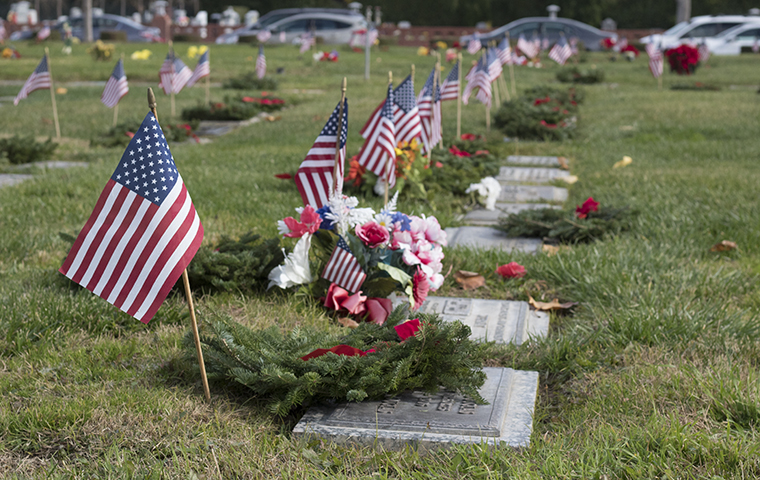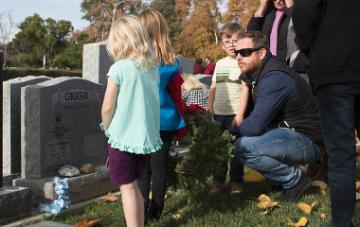
Wreaths Across America
ROTC lends a hand at holiday event saluting veterans’ service, sacrifice.
Since his father’s death four years ago, Chad Greer ’10 and his family had sought to publicly mark James William Greer’s service to his country as a Vietnam veteran and early Silicon Valley engineer.
A novel holiday tradition this month helped them do that.
Along with tens of thousands of Americans nationwide, the Greers recently participated in Wreaths Across America Day, laying an evergreen wreath festooned with a bright red bow on the former U.S. Navy crewman’s grave at Los Gatos Memorial Park.
He is forever in good company.
Nearby, more than 2,300 other veterans’ graves–each one marked by a small American flag–also were adorned with a wreath, placed by dozens of volunteers. Through the help of Nina Phillips, executive assistant at SCU’s Military Science Department, 30 members of Santa Clara University’s Army ROTC unit, and six of the department’s leaders, were on hand to help.
“It’s more than decorating graves,” says Cindy Greer, Jim’s widow and Chad’s mother, who organized the event for the second year in a row.
At their gravesites, each veteran’s name was read aloud, along with a prayer or a blessing, and a thank you “so that they are not forgotten,” says Greer.

Chad Greer ’10 (right) honors his father at a Wreaths Across America event in Los Gatos.
ROTC Cadet Brian Walker ’20 volunteered for the second year, once again as a member of the unit’s color guard, before the wreath distribution.
“It’s important to be involved,” says the 20-year-old computer engineering major. “It honors people who have given their time, and even their lives, for our country.”
Not lost on the SCU junior is that he and his ROTC cohorts may someday be saluted with such a wreath, should their military service be met with tragedy.
“If it happens, it happens,” Walker says philosophically. “And if it does, we would know we had all done our best.”
The nationwide event, now in its 11th year, recognizes deceased veterans, whether or not they died in combat, says Amber Caron, spokeswoman for the non-profit Wreaths Across America, based in Columbia Falls, Maine.
The occasion, she says, is not meant to obscure either Memorial Day or Veterans Day. But as families gather round their holiday tables each December, many are missing a loved one stationed far away on active U.S. military duty, or a relative, now departed, who had served their country.
“Our executive director has a saying,” says Caron. “She believes that people die twice: on the day they pass away, and whenever their name is spoken for the last time. This event continues to keep their memory alive.”
That’s precisely Cindy Greer’s goal.
When she first approached Cesar Rocha, a family service counselor at Los Gatos Memorial Park, to talk about participating last year, he’d never heard of Wreaths Across America.
“To be quite honest,” Rocha recalls, “I didn’t think it was going to be so large.”
The inaugural event in Los Gatos drew about 400 visitors, says Greer, who with many others helped raise enough donations–at $15 per wreath–to amass 1,700. This year, they closed in on almost 2,400 wreaths, and by 2019 she hopes to top 2,800—the total number of veterans buried at the memorial park.
It’s the same around the nation, says Caron. As donations for the wreaths have climbed, so have the number of cemeteries that are participating, from 1,433 last year to 1,640 this year.
It was an overflow of holiday wreaths in 1992 at Worcester Wreath Co. in Harrington, Maine that sparked owner Morrill Worcester’s idea to honor veterans every third Saturday of December. By 2007, the event was on the map nationwide.
This year, donors purchased about 1.8 million wreaths. After the holidays, the wreaths will be collected, and recycled or composted.
Caron says it doesn’t make sense to use artificial wreaths instead of the balsam fir boughs, because over time, fake wreaths fade; sustainability experts also say the faux versions cannot be recycled.
“The evergreen is the symbol of life—that’s the whole point,” Caron emphasizes. Moreover, she notes, the tree farm rotates which tree branches are “tipped,” or cut, to make the wreaths, a pruning process that actually makes the boughs grow back fuller.
“It’s a really healthy and natural way to replenish the trees,” Caron says.
Thirty-year-old Chad Greer doesn’t mind doing any of the work, before or after the event.
“As the son of a veteran, I feel so privileged to be able to participate,” he says of his late 71-year-old father, who never got a college degree.
But by the time Jim Greer completed his Vietnam War service, he'd learned so much about equipment engineering aboard three U.S. Navy aircraft carriers that he was eagerly hired by such Silicon Valley tech giants as Fairchild Semiconductor, Raytheon, and LSI Logic, among other companies, during his lifetime.
“His experience in the Navy meant a lot to him,” says Chad. “It contributed to his passion for our country, and that is something he wanted to be passed down to us.”
Donations to Wreaths Across America -- $15 per wreath -- can be made anytime, leading up to next year's event. For more information, click here.
Photos by Andrea Yun ’20